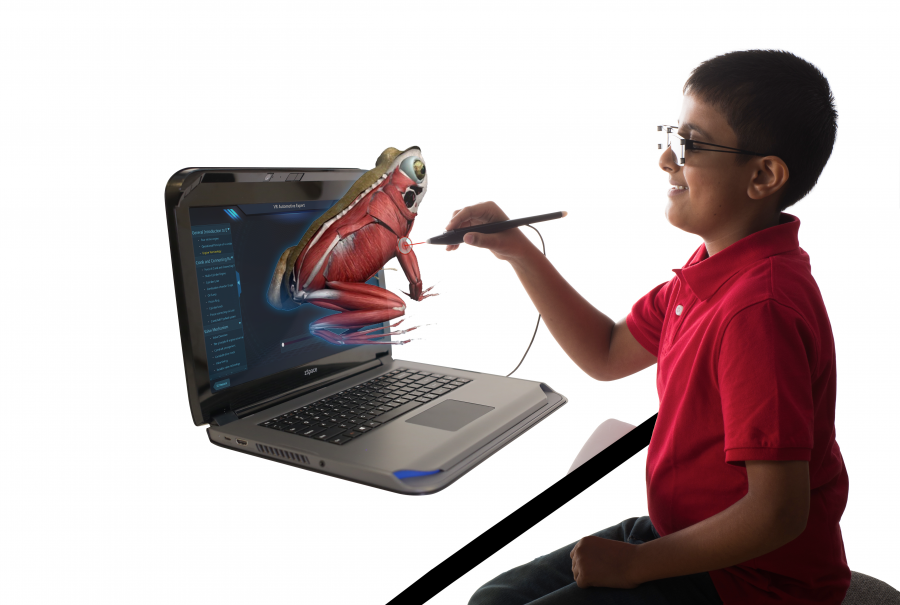Bring Science to Life With zSpace
Virtual reality (VR) and augmented reality (AR) are transforming the way educators deliver lessons to their students, and zSpace is one of the most promising examples of the form. Students and educators are both excited to engage with VR and AR in the classroom, and the data is clear on this. According to a study put together by Cerebrum, 97 percent of surveyed students are interested in trying VR in the classroom. A Samsung study of U.S. teachers found that 70 percent wanted to integrate VR and AR into their lesson planning. It’s rare for an educational technology to be so embraced by both student and teacher, but VR’s potential to engage and teach is obvious.
What’s also clear is that students have a particular fondness for science lessons delivered through VR or AR. Back in 2015, a Seattle-based nonprofit, Foundry 10, started a pilot program where they provided more than a thousand middle and high school students with VR headsets. The organization tracked how students used the technology, and it determined that science lessons were the most popular, with 44 percent of students saying that the science content was their favorite.
This is good news for zSpace users, because it comes with a wealth of science content and applications.
The Science of zSpace
zSpace makes use of both VR and AR technology, and consists of a few components. Every zSpace station includes a laptop, zSpace’s AIO or AIO PRO, and this is what students use as the delivery method for VR or AR content. Special eyewear is required to use zSpace, and two sets of eyewear are provided for each workstation, so students can operate the system in pairs. A stylus is used to interact with VR objects by picking them up or rotating them, and each workstation is compact enough to fit on a typical school desk or table.
Though the technology is impressive, it’s zSpace’s educational applications and content that drive student engagement and teacher lesson planning.
From Atoms to the Universe
There are hundreds of content modules available through zSpace, many of which are dedicated to the sciences. Further, zSpace has developed a handful of science-based applications, which are designed to be interactive and entertaining. Some of those applications include:
- Newton’s Park – Newton’s Park is a physics sandbox where students are encouraged to explore how physics and objects interact. The emphasis is on learning Newtonian physics, and the application uses a variety of blocks, balls and materials to do so. Force applicators and ramps are also available. All of these objects can be arranged as the student sees fit, and can run simulations to see these objects interact with set parameters. For example, students can change how gravity is represented in their physics playground, reducing it as if the student was on the moon, or cranking it up to simulate Jupiter.
- Franklin’s Lab – Franklin’s Lab offers a safe environment for students to experiment with electrical circuits, and students are encouraged to do so in the pursuit of solving problems. Available materials include batteries, wires, resistors, lights, motors and switches. Franklin’s Lab allows students to build their own circuits, or students can open up a prebuilt scenario where they have to create a circuit with limited resources.
- Curie’s Elements – Curie’s Elements offers an interactive periodic table that provides an atomic and Bohr model of each element. With Curie’s Elements, students can build atoms and explore the applications of each element. Students can even see how much of each element is found inside the human body.
- Labster – Labster is designed for high school students and makes it easy to set up experiments without needing a traditional lab. With Labster, students can explore the nature of light and optics, polarization, mass, electromagnetism, chemical reactions, kinetic energy and a lot more.
The above applications can provide students with endless opportunities to learn science, but zSpace offers much more than a handful of applications. It also has hundreds of learning modules that cover an incredible range of topics.
It would be impossible to list them all, but here’s just a small sample of the covered topics: The Ozone layer, clouds, the nature of matter, caves, plate tectonics, the carbon cycle, the water cycle, exploring the moon and the solar system, living in space, launching a rocket, exploring Earth’s orbit with NASA, human anatomy, the brain and other organs, the body’s various systems, the properties of water, proteins, lipids, animal and plant cells, biomes, ecosystems, trees and leaves, biotechnology, growing plants, chloroplasts, bacteria and viruses, cell mitosis and meiosis, animal classification, various animal lifecycles, fossils, the ocean, the desert, human evolution, dinosaurs, DNA, inheritance, disease, human impacts on the environment, pollination, predators and prey, the food chain, symbiosis, invasive species, zoology, material properties, ions, atoms, metals and nonmetals, chemical bonding, molecules, electrical conductivity, energy, chain reactions, the phases of matter, forces, gravity, friction, momentum, projectiles, motion, tools and how airplanes fly.
If it seems like that list goes on forever, keep in mind that this is just a small portion of what’s offered. If it’s something that students would be interested in, chances are zSpace has a content module developed for it already. In this way, zSpace can bring science to life, engaging students in hundreds of ways.



